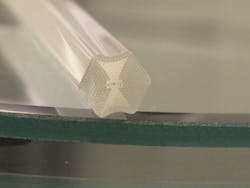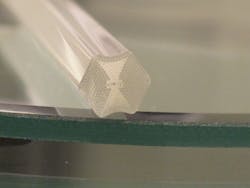Progress continues apace for a European project aiming to create a fully integrated photonic sensing "skin" that can be used anywhere that requires close monitoring of mechanical properties. The three-year European Commission-funded project, known as "photonic skins for optical sensing" (PHOSFOS), has now perfected its fiber-production methods and has its sights set largely on medical applications.
The 2.5-million-Euro PHOSFOS project is being led by Francis Berghmans of the Free University Brussels in Belgium, in collaboration with a number of European universities and the nanotechnology firm IMEC (Leuven, Belgium). At the project's heart is the use of fiber Bragg gratings created in silica fibers, microstructured fibers, or exotic plastic optical fibers. Those in turn are to be embedded in a thin foil or skin which the team envisions could be put to uses ranging from dentistry to civil engineering.
Key to the whole enterprise, Berghmans says, is the integration of the elements—the ability to integrate the optical sensing functionality with on-board signal processing, a power source, and even wireless communication inside the flexible polymer skin. The skin can then be tacked to, wrapped around, or built into any shape the application requires.The idea for PHOSFOS came from a longstanding collaboration. "We were working with microstructured fibers and had collaborations with the University of Ghent and IMEC," Berghmans says. "They had the microsystems technology, thinning diodes down until they were flexible. We said it would be great if we could combine everything to achieve these fully fledged integrated sensor systems."
Insensitive to temperature
But making fiber Bragg gratings in a number of types of fibers while maintaining optical performance wasn't—and still isn't—a straightforward business. One principal problem was limiting the temperature sensitivity of the photonic skins; they should measure the same mechanical properties regardless of the ambient temperature. Berghmans is somewhat guarded about the secret but says that the team now has fibers with a temperature sensitivity so low as to be unmeasurable.
"You have to take advantage of the thermal properties of the polymer fiber; normally these things are quite sensitive to temperature, but if you thermally treat them in a proper way, you can achieve writing multiplex gratings."
Most recently, the team pulled off a landmark result: fiber Bragg gratings with features smaller than ever before, made point by point with an ultrafast near-IR laser.1 Each period of the grating is made with a single pulse, and the grating is built up by translating the fiber through the focused spot. The team's method is simple—their optical setup doesn't even attempt to account for the curvature of the fiber, for instance—so it bodes well for large-scale manufacturing in the future.
For now, the team is working to make the production of the fibers reliable and repeatable. The European-funded part of the project finishes early next year and potential uses for the skins are already mounting up.
"The killer applications are definitely in the medical field," Berghmans notes. "We're now working toward a demonstrator for respiratory monitoring, and there's another project in artificial limbs or 'smart prosthetics.'"
REFERENCE
- T. Geernaert et al., Opt. Lett. 35, p. 1647 (2010).


